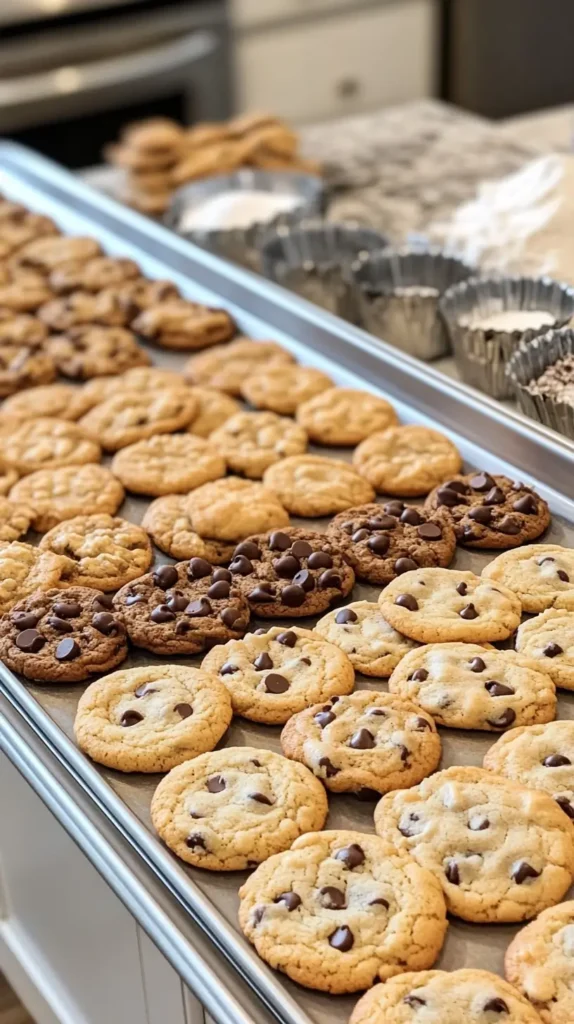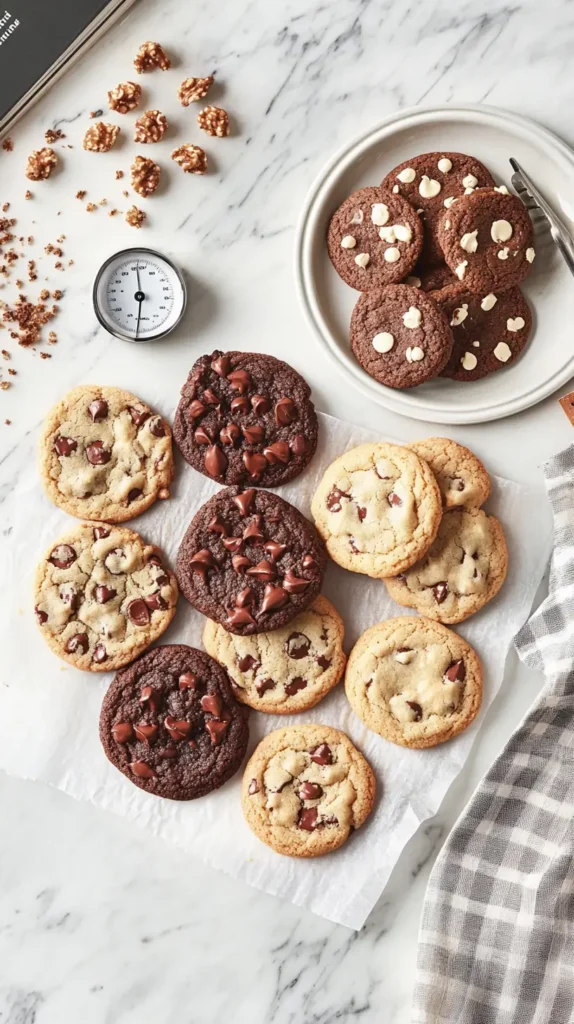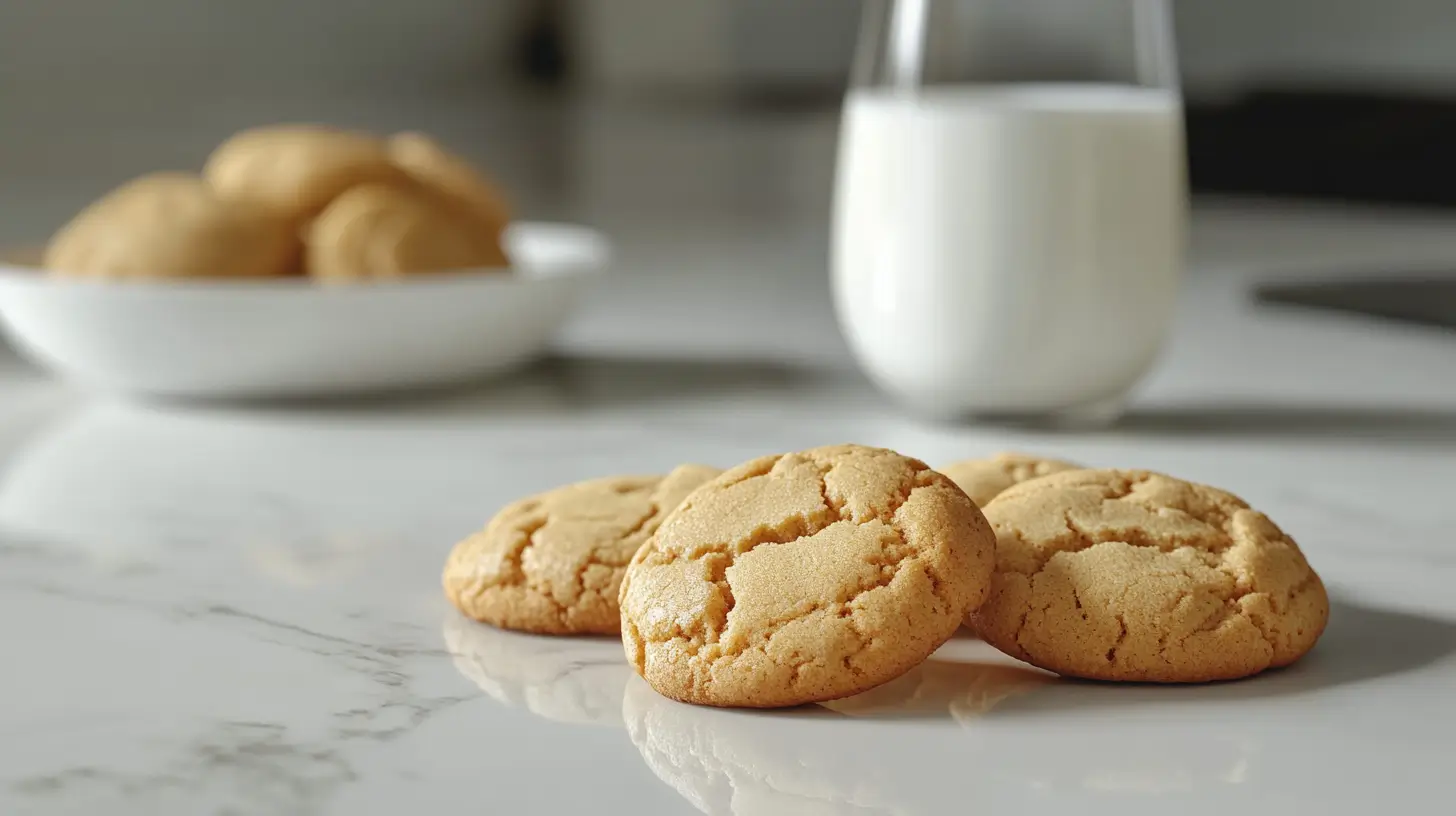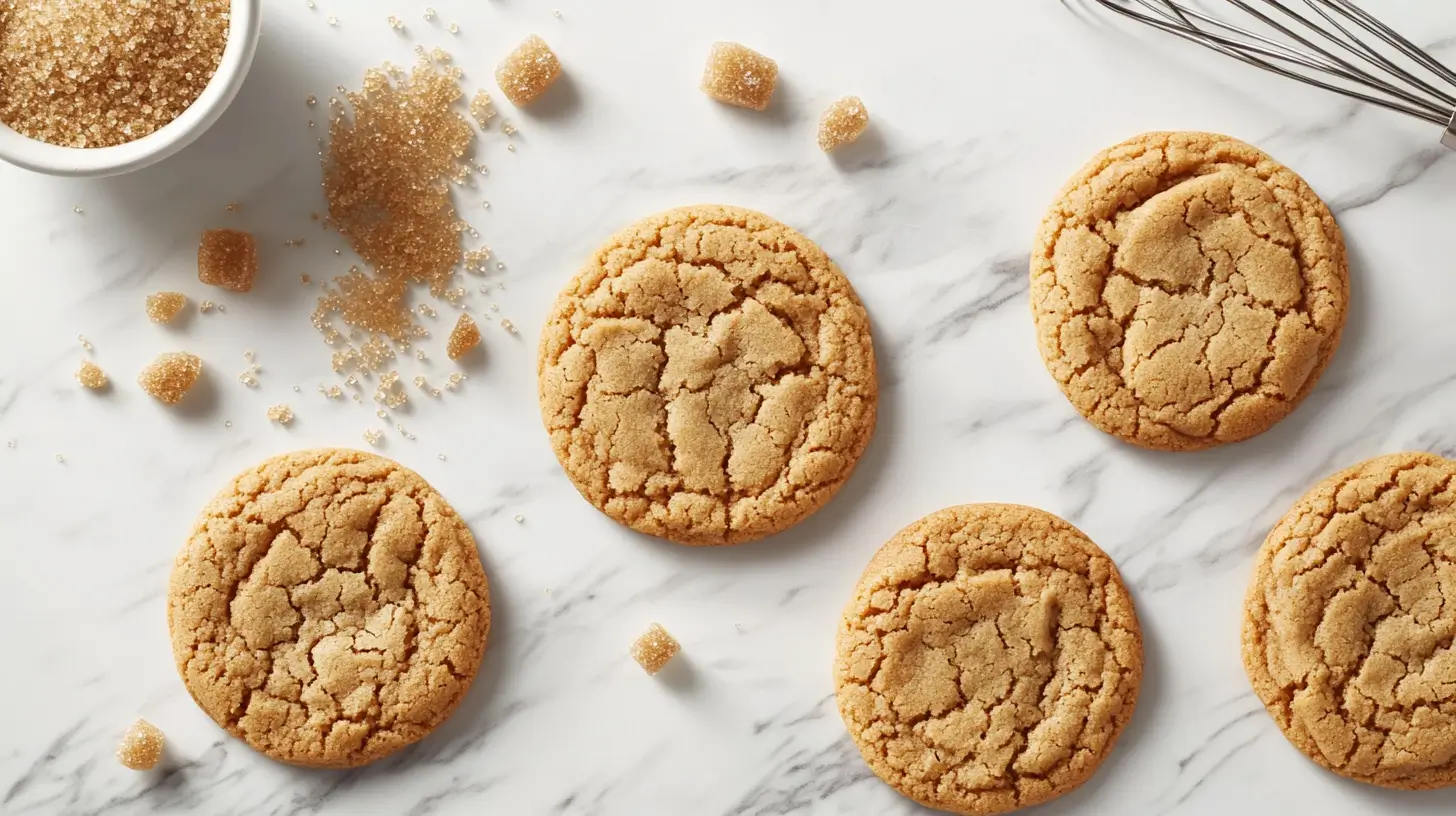Introduction
Baking cookies is an art and a science, requiring careful attention to ingredients, techniques, and most importantly, temperature. What temperature should cookies be baked at is a question every home baker and professional asks, as it directly affects the outcome of the cookies’ texture, flavor, and appearance. This article delves deep into every aspect of cookie baking, providing detailed insights to ensure your cookies turn out perfect every time.
What Makes Baking Cookies Unique?
Baking cookies stands apart from other culinary processes because of its precision. The balance between sugar, flour, and fat interacts uniquely with heat, creating the delightful textures and flavors we all love. What temperature should cookies be baked at plays a crucial role, as even minor deviations can result in cookies that are too hard, too soft, or improperly baked.
Key factors that set cookie baking apart include:
- The interplay of ingredients with heat.
- The importance of maintaining a consistent baking temperature.
- The impact of environmental factors like altitude and humidity.
By understanding these elements, bakers can achieve superior results every time.
Importance of Temperature in Cookie Baking
Temperature is more than just a setting on your oven—it’s the backbone of cookie baking success. When considering what temperature should cookies be baked at, it’s vital to remember that heat determines how the dough rises, spreads, and sets.
Key roles of temperature in baking cookies:
- Ensures proper caramelization of sugar for flavor development.
- Affects the Maillard reaction, which adds depth to the cookie’s color and taste.
- Controls the moisture content, influencing whether cookies turn out soft or crispy.
Every recipe has an ideal temperature range, and learning to manage it is essential for consistent baking.
Ideal Temperature for Cookies
The ideal baking temperature for cookies typically falls between 325°F (163°C) and 375°F (190°C). This range allows for even baking and ensures the cookies retain their intended texture and flavor. Understanding what temperature should cookies be baked at within this spectrum depends on the type of cookie you’re baking.
- 325°F: Results in soft and tender cookies.
- 350°F: Strikes a balance between soft centers and slightly crisp edges.
- 375°F: Produces cookies with a crispy texture and golden-brown exterior.
Each recipe may call for slight adjustments, but staying within this range will minimize errors.
Exploring the Most Popular Cookie Baking Temperatures
Recipes often specify precise temperatures for baking, but understanding the reasoning behind them is key to adapting and improvising. Knowing what temperature should cookies be baked at in different scenarios will help you tailor the results to your preference.
Popular cookie baking temperatures:
- 325°F: Ideal for delicate cookies, like shortbread or sugar cookies.
- 350°F: The go-to temperature for most cookie recipes, ensuring even cooking.
- 375°F: Great for cookies that require a crunchy bite, such as oatmeal or gingersnaps.
If you’re experimenting, start with the lower end of the range and adjust based on desired results.
Variations in Temperature Based on Cookie Type
Different cookies thrive at different temperatures, emphasizing the importance of matching heat to the dough. Understanding what temperature should cookies be baked at involves recognizing the needs of various cookie types.
Examples:
- Soft and Chewy Cookies: Bake at 325°F for gentle cooking and moisture retention.
- Crispy Cookies: Opt for 375°F to encourage spreading and browning.
- Specialty Cookies: Vegan or gluten-free cookies may require mid-range temperatures, around 340°F, to ensure structure without over-browning.
By adapting the temperature to the cookie type, you can ensure the best results.
Science Behind Baking
How Heat Affects Cookie Baking Temperatures and Results
Heat transforms raw dough into cookies by triggering chemical reactions. What temperature should cookies be baked at impacts these reactions, including:
- Butter Melting: Begins around 90°F, affecting how much the cookies spread.
- Egg Proteins Coagulating: Occurs between 144°F and 158°F, providing structure.
- Starch Gelatinization: Begins at 150°F, contributing to texture.
These stages highlight why precise temperature control is necessary for successful baking.
How Temperature Affects Texture, Flavor, and Appearance
Temperature directly influences the outcome of cookies, dictating their final characteristics. When considering what temperature should cookies be baked at, remember:
- Low Temperatures (325°F): Promote softer cookies with minimal spreading.
- Medium Temperatures (350°F): Balance crispiness and chewiness.
- High Temperatures (375°F): Enhance browning and create a crunchy texture.
Balancing temperature with other factors, such as bake time and ingredient ratios, ensures perfection.
Cookie Types and Their Needs
Soft and Chewy Cookies
For soft, chewy cookies, what temperature should cookies be baked at is often 325°F to 350°F. Lower heat allows for slower cooking, preserving moisture while allowing sugar to caramelize gently.
Tips for soft cookies:
- Use more brown sugar for added moisture.
- Chill the dough to limit spreading.
Crispy Cookies
Crispy cookies require higher temperatures, typically around 375°F. Heat encourages faster cooking, creating a crunchy exterior.
Characteristics of crispy cookies:
- Thin, with a wide spread.
- Deep golden color due to browning.
Specialty Cookies (Gluten-Free, Vegan, etc.)
Specialty cookies may require mid-range temperatures and extra attention. Gluten-free doughs often lack structure, so baking at what temperature should cookies be baked at—around 340°F—ensures even cooking without over-baking.

Baking Equipment
Choosing the Right Oven for Perfect Cookie Baking Temperatures
Modern ovens with consistent heat distribution are ideal for baking cookies. When choosing an oven, consider:
- Convection ovens for even airflow.
- Standard ovens with accurate thermostats.
How to Use an Oven Thermometer for Accurate Temperatures
Oven thermometers are essential for precision. Place the thermometer in the center of the oven to ensure your settings match the actual temperature, helping you nail what temperature should cookies be baked at every time.
Preheating the Oven
Preheating for Accurate Cookie Baking Temperatures
To achieve consistent results, preheating ensures the oven reaches the correct temperature before baking begins. Missing this step can cause uneven cooking, which may render knowing what temperature should cookies be baked at ineffective. Always allow enough time for the oven to heat up properly before placing your cookies inside.
Tips for Effective Preheating
- Preheat for at least 10-15 minutes.
- Use an oven thermometer to verify accuracy.
Adjusting Temperatures
How Cookie Baking Temperatures Impact Results
High temperatures cook quickly, creating crisp edges, while low temperatures cook slowly for softer results. Adjust what temperature should cookies be baked at depending on your preferences.
Recovering from Temperature Mistakes
If cookies bake too fast or too slow, adjust the temperature in 5°F increments. Always monitor the baking process closely.
Environmental Factors
Impact of Altitude on Cookie Baking
At higher altitudes, lower air pressure affects baking. Adjust what temperature should cookies be baked at by increasing oven temperature slightly (about 15-25°F) and reducing baking time.
Effects of Humidity and Climate
Humidity can soften dough, affecting spread and texture. In humid climates, slightly increasing baking temperature ensures proper setting.
Troubleshooting Cookie Baking
Common Cookie Problems and Solutions
Even with careful preparation, cookie baking sometimes goes awry. Knowing how to troubleshoot issues is key to achieving the perfect results. Many problems, like uneven spreading or overcooked edges, can be traced back to what temperature should cookies be baked at.
Common problems and solutions:
- Cookies Spread Too Much: Lower the oven temperature by 5°F, and chill the dough before baking.
- Hard Cookies: Bake at a slightly lower temperature to retain moisture.
- Undercooked Centers: Increase the temperature by 5°F or extend the baking time by a minute.
By addressing these issues promptly, you’ll avoid wasting time and ingredients.
Signs of Overbaking or Underbaking
Understanding the signs of overbaking or underbaking is crucial for cookie success. What temperature should cookies be baked at becomes irrelevant if you overlook these signs.
Overbaked Cookies:
- Appear overly dark or brown.
- Feel dry or hard when cooled.
Underbaked Cookies:
- Have shiny or wet centers.
- Collapse after cooling.
Adjusting bake time or temperature ensures your cookies are consistently well-baked.
Experimenting with Temperatures
How to Create Custom Cookie Textures
Customizing cookie textures begins with mastering what temperature should cookies be baked at. Adjusting temperature affects moisture, spread, and browning.
Texture tips:
- For Soft Cookies: Bake at 325°F and reduce baking time slightly.
- For Crunchy Cookies: Bake at 375°F and extend the time by a minute or two.
- For Balanced Cookies: Stick to 350°F and monitor closely.
Experiment with these adjustments to find your preferred cookie texture.
Finding the Right Balance Between Temperature and Time
Temperature and time work hand in hand when perfecting cookies. Even if you know what temperature should cookies be baked at, balancing these variables is essential for consistent results.
Guidelines:
- High temperature = shorter baking time (crispy cookies).
- Low temperature = longer baking time (soft cookies).
- Mid-range temperature = balanced textures.
Testing small batches at varying settings is a great way to refine your approach.

Tips for Consistent Results
Maintaining Oven Calibration
One of the most common challenges bakers encounter is inaccurate oven temperatures. Knowing what temperature should cookies be baked at becomes irrelevant if your oven is off by 10°F or more, as this can significantly affect the results.
Steps to maintain calibration:
- Use an oven thermometer to verify temperature accuracy.
- Recalibrate your oven if necessary by following the manufacturer’s instructions.
- Check calibration every 6 months to ensure consistent results.
Consistency in Cookie Size and Placement on the Baking Tray
Consistency in size and spacing ensures cookies bake evenly. Uneven baking can occur even if you know what temperature should cookies be baked at.
Tips for consistency:
- Use a cookie scoop to ensure uniform sizes.
- Space cookies evenly on the tray (at least 2 inches apart).
- Bake one tray at a time for the most even results.
Following these practices guarantees better baking outcomes.
Comparing Baking Methods
Conventional Ovens vs. Convection Ovens
Understanding your oven type can help refine what temperature should cookies be baked at. Conventional ovens rely on still air, while convection ovens use fans to circulate heat.
Comparison:
- Conventional Ovens: Bake at the recipe-specified temperature; suitable for all cookie types.
- Convection Ovens: Reduce the temperature by 25°F to prevent overbaking.
Choose the method that aligns with your baking goals.
Using Air Fryers or Toaster Ovens
Air fryers and toaster ovens can be convenient alternatives for small batches of cookies. When determining what temperature should cookies be baked at in these devices, consider their rapid heating capabilities.
Tips:
- Air fryers: Set the temperature 10-15°F lower than traditional ovens.
- Toaster ovens: Monitor closely as cookies may brown faster.
Experimentation is key to success with these methods.
Advanced Techniques
Baking with Specialty Ingredients
Specialty ingredients, such as alternative flours or plant-based substitutes, often require adjustments to what temperature should cookies be baked at. Since these ingredients behave differently under heat, careful temperature modifications are necessary to achieve the desired results.
Guidelines:
- Gluten-free flours: Lower the temperature slightly to avoid over-drying.
- Plant-based butters: Use mid-range temperatures for even spreading.
Testing with small batches ensures the best results.
Using Multiple Temperature Stages for Complex Recipes
Some recipes gain an advantage from being baked at multiple temperatures, as this technique helps create complex textures and enhances flavors. For example, cookies can be started at 375°F to encourage browning and then finished at 325°F for a tender center. Understanding what temperature should cookies be baked at at each stage helps refine this technique.
Safety Considerations
Handling Hot Equipment Safely
Working with high temperatures requires caution. While focusing on what temperature should cookies be baked at, don’t forget safety protocols.
Safety tips:
- Always use oven mitts or heat-resistant gloves.
- Allow baking trays to cool before handling.
- Use racks to transfer cookies safely.
Avoiding Burns and Other Baking Hazards
Burns and injuries are common risks in a busy kitchen, making safety a top priority. Along with understanding what temperature should cookies be baked at, it is essential to follow safe practices to prevent accidents.
Prevention:
- Keep oven doors closed when not in use.
- Turn off the oven immediately after baking.
- Store sharp and hot tools safely.
Prioritizing safety ensures an enjoyable baking experience.
FAQs About Cookie Baking
Is it better to bake cookies at 350 or 375?
The ideal temperature for baking cookies depends on the type of cookie and the texture you want to achieve. For instance, baking cookies at 350°F provides a perfect balance between soft centers and slightly crispy edges. Moreover, this temperature ensures the cookies spread moderately while cooking evenly throughout. On the other hand, 375°F is better for cookies that you want to be crisper or have a deeper golden color. The higher heat cooks them faster, promoting browning and crispiness but with slightly less spreading. For chewy cookies, 350°F is typically preferred, while 375°F works well for thinner, crunchier varieties.
What is the best temperature and time to bake cookies?
The best temperature and time for baking cookies largely depend on the specific recipe and the outcome you wish to achieve. Generally:
- Temperature: 325°F to 375°F is the sweet spot for most cookies.
- Time: Bake cookies for 8–12 minutes. At 325°F, cookies may take closer to 12 minutes, resulting in a softer texture. At 375°F, cookies may take as little as 8 minutes, producing a crisp exterior. Always check the cookies a minute or two before the end of the suggested baking time to prevent overbaking.
What is the best oven setting for cookies?
The best oven setting for baking cookies is “Bake” mode in a conventional or convection oven.
- Conventional Oven: Use the standard “bake” setting and rotate the tray halfway through baking for even results.
- Convection Oven: Lower the temperature by 25°F (e.g., bake at 325°F instead of 350°F) and enjoy quicker, more evenly baked cookies due to the circulating air.
Avoid using settings like “broil,” as they can cause cookies to brown unevenly or burn the tops before the centers are fully baked.
Is it better to bake cookies at high or low temperature?
The choice between high and low temperatures depends on the desired cookie texture:
- High Temperatures (375°F): Best for cookies that are crisp and golden-brown. The faster cooking time encourages browning but limits spreading, creating cookies with crunchy edges and thinner profiles.
- Low Temperatures (325°F): Ideal for soft, tender cookies with more moisture. The slower baking process ensures even cooking and minimal browning, resulting in a chewy interior.
In most cases, baking cookies at a moderate temperature (350°F) provides the best balance between crispiness and softness.
Conclusion
Recap of Key Points
This guide comprehensively covered every detail of cookie baking, ranging from troubleshooting common issues to exploring advanced techniques. Knowing what temperature should cookies be baked at is the cornerstone of successful baking, but balancing temperature, time, and technique ensures consistently perfect cookies.
Encouragement to Experiment and Learn
Baking is both a science and an art. Experimenting with different temperatures and methods not only allows you to develop your unique style but also enhances your baking skills over time. With this knowledge in hand, you’re fully prepared to bake cookies that will delight everyone, every single time. Therefore, keep exploring, stay curious, and enjoy the rewarding process of baking!





